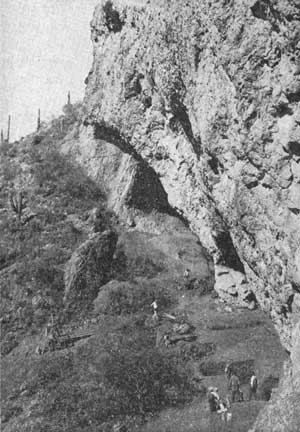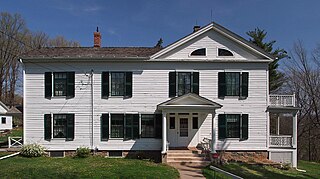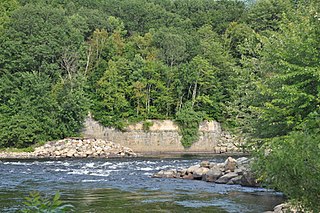Related Research Articles

Lubbock Lake Landmark, also known as Lubbock Lake Site, is an important archeological site and natural history preserve in the city of Lubbock, Texas. The preserve is 336 acres and is a protected state and federal landmark. There is evidence of ancient people and extinct animals at Lubbock Lake Landmark. It has evidence of nearly 12,000 years of use by ancient cultures on the Llano Estacado. It is part of the Museum of Texas Tech University.

This is a list of the National Register of Historic Places listings in Franklin County, Ohio.

The Lindenmeier site is a stratified multi-component archaeological site most famous for its Folsom component. The former Lindenmeier Ranch is in the Soapstone Prairie Natural Area, in northeastern Larimer County, Colorado, United States. The site contains the most extensive Folsom culture campsite yet found with calibrated radiocarbon dates of c. 12,300 B.P.. Artifacts were also found from subsequent Archaic and Late pre-historic periods.

Ventana Cave is an archaeological site in southern Arizona. It is located on the Tohono O'odham Indian Reservation. The cave was excavated under the direction of Emil Haury by teams led by Julian Hayden in 1942, and in 1941 by a team led by Wilfrid C Bailey, one of Emil Haury's graduate students. The deepest artifacts from Ventana Cave were recovered from a layer of volcanic debris that also contained Pleistocene horse, Burden's pronghorn, tapir, sloth, and other extinct and modern species. A projectile point from the volcanic debris layer was compared to the Folsom Tradition and later to the Clovis culture, but the assemblage was peculiar enough to warrant a separate name – the Ventana Complex. Radiocarbon dates from the volcanic debris layer indicated an age of about 11,300 BP.
The Cooper Bison Kill Site is an archaeological site near Fort Supply in Harper County, Oklahoma, United States. Located along the Beaver River, it was explored in 1993 and 1994 and found to contain artifacts of the Folsom tradition, dated at c.10800 BCE to c. 10,200 BCE in calibrated radiocarbon years. Findings include projectile points, the bow and arrow not yet being in use at this date. The projectile points are the results of hunters killing bison in an arroyo. The hunters of this culture found the site continuously useful; the known artifacts are believed to be the results of three different hunts.

Folsom site or Wild Horse Arroyo, designated by the Smithsonian trinomial 29CX1, is a major archaeological site about 8 miles (13 km) west of Folsom, New Mexico. It is the type site for the Folsom tradition, a Paleo-Indian cultural sequence dating to between 11000 BC and 10000 BC. The Folsom site was excavated in 1926 and found to have been a marsh-side kill site or camp where 32 bison had been killed using distinctive tools, known as Folsom points. This site is significant because it was the first time that artifacts indisputably made by humans were found directly associated with faunal remains from an extinct form of bison from the Late Pleistocene. The information culled from this site was the first of a set of discoveries that would allow archaeologists to revise their estimations for the time of arrival of Native Americans on the North American continent.

Prospect House, known also as just Prospect, is a historic house on the Princeton University campus in Princeton, Mercer County, New Jersey, United States. Built in 1851, it is a fine example of the work of architect John Notman who helped popularize Italianate architecture in America. Notable residents include Woodrow Wilson during his tenure as president of the university. The building now serves as a faculty club. It was designated a National Historic Landmark in 1985 for its architecture and historic associations.

Blackwater Draw is an intermittent stream channel about 140 km (87 mi) long, with headwaters in Roosevelt County, New Mexico, about 18 km (11 mi) southwest of Clovis, New Mexico, and flows southeastward across the Llano Estacado toward the city of Lubbock, Texas, where it joins Yellow House Draw to form Yellow House Canyon at the head of the North Fork Double Mountain Fork Brazos River. It stretches across eastern Roosevelt County, New Mexico, and Bailey, Lamb, Hale, and Lubbock Counties of West Texas and drains an area of 1,560 sq mi (4,040 km2).

This is a list of the National Register of Historic Places listings in Bexar County, Texas.

This is a list of the National Register of Historic Places listings in El Paso County, Texas.

This is a list of the National Register of Historic Places in Presidio County, Texas
The Burro Mesa Archeological District encompasses a quarry in Big Bend National Park used by Native Americans as a source of chert for chipped-stone tools. The quarry was used intermittently beginning in the paleoindian period starting about 12,000 to 13,000 years ago. The chert is found in a variety of colors and rests on top of tuff beds which themselves contain veins of kaolinite that was suitable for making claystone ornaments and beads. The quarry area is carpeted with lithic debris from the initial knapping process by which chert was rough-shaped into material of suitable size and shape for later refinement at more convenient locations.

The Folsom House is a historic house museum at 272 West Government Street in Taylors Falls, Minnesota, United States.

This is a list of the National Register of Historic Places listings in Briscoe County, Texas.

The Folsom Hotel, at southwest of junction of Grand Ave. and Wall St. in Folsom, New Mexico, is a historic stone building built in 1888 that served as a department store and as a hotel. It was listed on the U.S. National Register of Historic Places in 1987.

The Beaver Meadow Brook Archeological Site is a prehistoric Native American village or camp site in New Hampshire. Located near Sewall's Falls on the west bank of the Merrimack River, the site includes evidence of occupation during Middle and Late Archaic periods, as well as during the Woodland precontact period. Finds at the site include a stone axe and numerous tools for working stone, as well as projectile points and bone fragments. The site also has several hearths, evidence of significant occupation during the Woodland period.

Mochong is a major prehistoric archaeological site on the island of Rota in the Northern Mariana Islands. It is considered the best preserved and second largest latte village in the Marianas. It is an extensive village site on the northern side of the island comprising 50 individual latte sets, scattered mortars (lusongs), scattered subsurface artifacts such as tools, fishing implements and abundance pieces of pottery; the Marianas Red Ware Pottery and the Marianas Plain Ware Pottery. This site also includes an extremely rare latte house structure consisting of 14 columns. It also has a latte stone wall, consisting of six columns and five slabs, that is more than 50 feet (15 m) long. The site has been radiocarbon dated to c. 1000 BCE. The site was first sketched in the early 19th century by the French explorer Louis de Freycinet, and was in remarkably intact condition in the 1980s.
The Winooski Archeological Site, designated VT-CH-46 by state archaeologists, is a prehistoric Native American site in the city of Winooski, Vermont. First identified in 1972, it is one of the largest Native encampment sites of the Middle Woodland period in the northeastern United States. It was listed on the National Register of Historic Places in 1978, at which time it was recognized as one of just two stratified Woodland period sites in the state.

Folsom Depot is a former train station in Folsom, California.
This is a list of the National Register of Historic Places listings in Texas' High Plains.